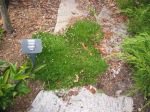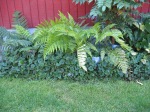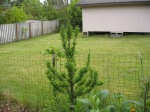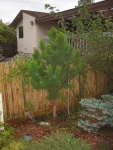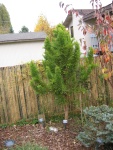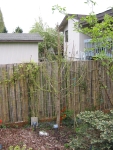- Japanese Tassel Fern
- Korean Rock Fern
- Autumn Fern
- Deer Fern
- Hart’s Tongue Fern
- Long Eared Holly Fern
- Indian Holly Fern
- Japanese Painted Fern
- Alaska Fern
- Ghost Fern
- Soft Shield Fern
- Licorice Fern
- Western Sword Fern
- Mystery Fern #1
- Mystery Fern #2
July is a wonderful time for ferns. You’d think the hot weather would dry them up, and it’s true that you have to keep them well watered. But if you do you’re rewarded with some amazing growth and beautiful lacy foliage that offers a different kind of garden. It’s so soft and easy on the eyes and touch. I love to just wander around and look at them and feel their gentle foliage now. They’re so big and full, especially the deciduous ones, of which I only have a few at this point. I’ve decided to go for mostly evergreen ones because I get to enjoy their foliage all year round.
First up here in this tour is a Japanese Tassel Fern, or Polystichum polyblepharum. It’s one I just planted last year and it’s tripled or more in size since then. It seems to like its new home a lot and so do I. It’s in a bed with the second one here, the Korean Rock Fern, or Polystichum tsus-sinensis. I put in 3 of these because they grow so small and I thought they’d form a nice clump, which they’re doing now. This bed looks wonderful with all the green in it.
Next is an Autumn Fern, or Dryopteris erythrosora, a common fern in many of our gardens. The new fronds come out bronze which is how it got its name, tho it does so in spring, not autumn. A lovely and delicate fern that gets about 2-3 feet big. Following that is a Deer Fern, or Blechnum spicant, a native of the Pacific Northwest. It has two forms of fronds -a fertile one and an infertile one that you can see high up. The fertile ones are smaller, or do I have that backwards? I never can remember…
This one is a very different kind of fern in that it looks like something that couldn’t possibly be a fern. But it is. It’s a Harts Tongue Fern, or Asplenium scolopendrium. It’s doubled in size just this year so it’s happy where it is and I am too. The next one is odd looking because I didn’t bother to cut off the dead fronds because I love the colors they turn so much. It’s a Long Eared Holly Fern, or a Polystichum neoloblatum. It gets to about 2 feet tall and has prickly leaves, not the usual soft ones we expect from ferns. But it’s a lovely plant and is still putting on new leaves even as I write this.
Next to it is an Indian Holly Fern, or Arachnioides simplicior “Variegata”. I’ve noticed that for the last few years it only puts on 3 fronds a year but this year it seems to be sending up 4 or even 5 perhaps. They have this lovely yellow stripe down the center of the leaves and look cool with their long stems and tufts of foliage at the ends of them. This next one looks burned, and it is. It’s in too sunny a place for now but in a few years it’ll be in shade because of the tree I planted above it. For now tho this Japanese Painted Fern, or Athyrium nipponicum “Pictum”, will just have to deal with the heat and sun and it’s still doing well so I guess it’s happy enough. I hope so as I love it in the spring when it’s more light colored and mostly got a blue tint to it.
This Alaska Fern, or Polystichum setiferum, is the biggest fern I have. It’s grown so huge I’m totally amazed. It was supposed to get to to 2 feet and it’s way bigger than that now. I love it and it seems to love its place in the garden as well. A beautiful specimen. It’s native to much of Southern Europe. The next one is another PNW native called a Licorice Fern for the taste of the roots which have a licorice flavor. It’s a Polypodium glycyrrhiza and spreads well beneath this Mountain Hemlock you can see above it. A nice native combination of plants here.
The next is a Soft Shield Fern, or Polystichum setiferum “Diversilobum” that is closely related to the Alaska fern. It’s a cultivar of it in fact and grows with a twist to the leaves I find intriguing. It hasn’t gotten too big yet but I have hopes for it in time. The next one is a real favorite of mine. It’s a Ghost Fern, or Athyrium x Ghost, a deciduous fern along with the Japanese Painted Fern to which it’s closely related. In fact the Japanese Painted Fern is one parent of this one along with the Mother fern. It has wonderful pale grey foliage and has gotten quite tall which surprised me with its height. I’m so happy it’s doing well here.
The last row starts with another well known native – the Western Sword Fern, or Polystichum munitum. It can get up to 6 feet tall in its native habitat. I need to move it to a better location where it can get bigger and not be in the way of our ladders when we work on the house. I have a whole row of these under the edge of the north side hedge to create a ferny tunnel there. It’s pretty cool looking as it grows and they get big.
The last two ferns are an embarrassment to me, who is so careful about knowing just what I’m growing and have labeled almost everything in the garden. Well not these two. I can’t find the original labels! What a shock this was to me when it was time to make my botanical plaques I have on all the other plants. I haven’t a clue what these are, so if you recognize them please let me know. I think one may be a Male Fern, or Filix mas, but I’m not sure. I know it’s not the Lady Fern because I have some wild in the garden but none were in good shape to photograph. I like them both and both of them are deciduous for the most part. They create a nice corner of green in the front yard where they are.
So that’s the tour. Not too long I hope and full of beauty and plants. I’m happy to be able to grow ferns but I’ve lost several of them over time and didn’t include others that just didn’t look good enough now. I tried several maidenhair ferns before I gave up on them and I have a nice Alpine Water fern that is too burned to show now. But it’s nice next to the fountain and will be good as time allows it space to grow. As I said most of these are evergreen tho they look pretty ratty by the end of the season. Usually I tend to keep the fronds on all year tho because they look cool and I love the foliage to be present. I’ve taken to pruning some of them in early spring tho and others I leave to fill in on their own. How do ferns do in your garden? I hope you are able to grow them and have at least a few to marvel at. I’m so pleased to be able to show you these. They are so cool and shady and nice, even the ones in the sun….
Finding Ferny delights,
Steve
















